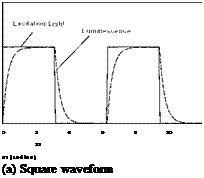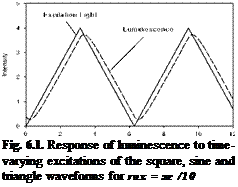Response of Luminescence to Time-Varying Excitation Light
6.1.1. First-Order Model
The lifetime method for PSP and TSP is based on the response of luminescence to a time-varying excitation light. The response of the luminescent emission I from a paint to an excitation light E(t) can be described as a first-order system
dl/dt = -1/t + E(t), (6.1)
where t is the luminescent lifetime. With the initial condition I(0) = 0, a solution to Eq. (6.1) is
I(t) = f exp[ -(t – u )/t ]E( u )du. (6.2)
Jo
For a pulse light E(t) = Am S(t), the luminescent response is simply an exponential decay
![]()
I(t) = Amexp( -1/t ). (6.3)
where m = 2kf is the circular frequency of the excitation light. Substitution of Eq. (6.4) into Eq. (6.2) yields the luminescent response after a short transient process
Here, the phase angles pn are related to the luminescent lifetime by
tan yn = nmx. (6.6)
In the simplest case where the sinusoidally modulated excitation light is E(t) = Am [1 + H sin( m t)] , the luminescent response Eq. (6.5) is reduced to
where Meff = (1 + x2 m2) 1/2 is the effective amplitude modulation index, Am is the amplitude, and H is the modulation depth. The phase angle ^ is related to the luminescent lifetime simply by
tan (p = rnx. (6.8)
Other waveforms of the excitation light include square and triangle. Figure 6.1 shows the luminescent response to typical periodic excitations with the square, sine and triangle waveforms for the non-dimensional lifetime of юх = ж/10 .
 2.5
2.5
2.0
>, 1.5
~ 1.0 0.5 0.0
 4.0
4.0
3.5
3.0 .= 2.5 = 2.0
1.5
1.0
 |
0.5
at (radian)
(c) Triangle waveform













